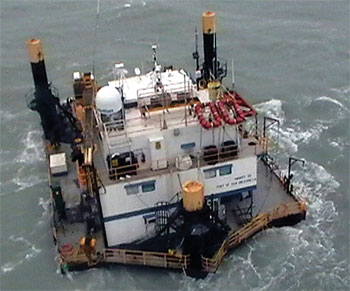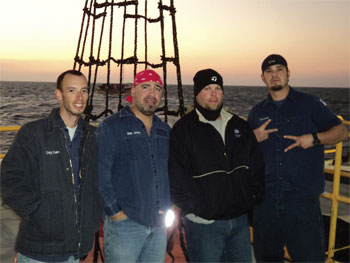The Trinity II disaster that killed four people happened because of poor weather planning and mishandling of life rafts, the National Transportation Safety Board (NTSB) has ruled.
The deaths occurred after the crew of the 94-foot jack-up lift boat abandoned the vessel in Mexico’s Bay of Campeche during Hurricane Nate on Sept. 8, 2011. After two life rafts failed to deploy properly, the 10 crewmembers clung to a life float for three days.
They had evacuated Trinity II because the vessel’s 145-foot stern jacking leg failed due to the force from the waves and from the weight of water on the deck, the NTSB said in an April 2013 report. An earlier, more orderly evacuation never happened because Hurricane Nate was born of a rapidly forming local storm that surprised the crew.
 |
|
Courtesy Mexican Navy |
|
Trinity II |
Two of the men killed were mariners with Trinity Liftboat Services of New Iberia, La. Another was an employee of seismic explorer Geokinetics, which had chartered the boat. The fourth was a contract oil worker.
Investigators said Trinity and Geokinetics had prepared hurricane contingency plans, but they never had time to evacuate the Trinity II crew in the face of this particular storm.
The NTSB said the probable cause of the deaths was the companies’ failure “to adequately plan for the risks associated with a rapidly developing surface low-pressure weather system, which ultimately subjected the elevated lift boat to hurricane-force conditions, causing the stern jacking leg to fail and the onboard personnel to abandon the vessel.”
Exacerbating the risk was “the failure of the Trinity II crewmembers to make effective use of the vessel’s available lifesaving equipment, resulting in the personnel’s prolonged exposure to the elements while awaiting rescue.”
Nate was not preceded by the customary hurricane warnings because no tropical storm had yet formed whose direction could be tracked.
“The plans assumed that weather systems affecting the area of operation would arrive from the east and thus provide a few days’ advance warning,” the investigators wrote. “Further, neither plan would be activated unless a named tropical weather system approached the area. However, in this accident, the conditions that eventually would produce Hurricane Nate developed locally from a strengthening surface low-pressure system.
“As a result, the company hurricane plans were never activated, and the personnel on board the Trinity II had minimal advance warning to prepare.”
The NTSB recommended that Trinity Liftboat Services and Geokinetics revise weather-preparedness plans to include contingencies for surface low-pressure systems and nontropical storms.
When they decided to abandon ship, Trinity II’s mariners failed to make proper use of all safety equipment available to them — in particular the two life rafts and the vessel’s emergency position indicating radio beacon (EPIRB).
“Inflating the life raft on deck — instead of throwing the canister containing the life raft into the water, which was the proper method and was clearly illustrated in the launching instructions posted where the life rafts were stowed — caused the life raft to blow away from the deck in the hurricane-force winds and vanish in the rough seas,” the NTSB wrote.
“The second life raft was also lost in the high winds after a large wave hit the canister, causing the life raft to inflate while still aboard the vessel.”
Crewmembers reported that they didn’t grab the EPIRB because it was stowed in an area of the boat where a crane was swaying dangerously in the wind. “The EPIRB, had it been brought along and activated, would have enabled search-and-rescuers to narrow the search area and reduce the time the men had to spend in the water,” the report said.
Francis Spagnoletti, an attorney representing some of the victims, agrees with the NTSB’s findings on the inadequate weather planning.
“The standby vessel should have been there for them,” Spagnoletti said. “They should have taken these guys off the day before.”
Spagnoletti said he hopes the Trinity II disaster focuses the industry’s attention on the safety of lift boats in the Gulf of Mexico. He said Trinity II, built in 1982, can work safety along a coastline but not offshore.
“That class of vessel should not be operating in tropical weather conditions in any kind of exposed environment,” Spagnoletti said. “You put (crew) in questionable circumstances whenever you put them out there in the summertime.”
Spagnoletti disagrees with the aspect of the report that questions the mariners’ actions during the harrowing evacuation, including attempts to deploy life rafts in 70 mph winds. “They were doing the best they could under extreme circumstances, so I take exception to that,” he said.
Trinity Liftboats didn’t respond to a request for comment on the NTSB report. Houston-based Geokinetics also didn’t respond.
The NTSB recommends that the Offshore Marine Service Association inform members about this casualty. The Coast Guard and OMSA should emphasize the need to tailor weather planning to such circumstances and to make clear that life rafts should not be inflated out of the water.

